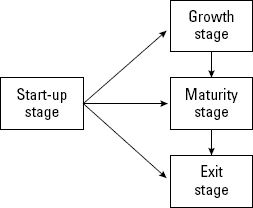Figuring Out When to Expand Your Product Line
With inventory, you're never deciding whether to drop a product; rather, you're deciding when to do so. Think about the last time you went grocery shopping. Did you notice that most food items had sell by (expiration) dates stamped on their packaging? If a product's sell by date has passed, the product shouldn't be purchased. Instead, it's eventually replaced on the store's shelves by a fresher product.
Most products (food or otherwise) have expiration dates, or at least life spans, because at some point, for whatever the reason, products are no longer valid. In marketing terms, a product's life span is referred to as its life cycle (see Figure 3-1).

Figure 3-1: The four stages of a product's life cycle.
Typically, a product's life cycle is defined in four stages:
- Start-up: As you introduce a product to the market, you're defining the product's place among your customers and building awareness for it.
- Growth: In a product's expansion phase, you're increasing sales, developing the customer base, and exploring alternative markets for growth.
- Maturity: When a product hits its prime, you have to protect its market share. You might notice more competitors at this stage. After a product hits its peak, try to eke out profitability for as long as possible.
- Exit: In a product's stage of decline, its sales are steadily decreasing and interest ...
Get Starting an Online Business All-in-One For Dummies®, 3rd Edition now with the O’Reilly learning platform.
O’Reilly members experience books, live events, courses curated by job role, and more from O’Reilly and nearly 200 top publishers.

